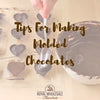
Tips for Making Molded Chocolates
2 min reading time

2 min reading time
Many people might think making molded chocolate is easy, but once you try to make them yourself, you’ll realize it’s quite the contrary. Despite using molds to create beautiful designs and consisting of one simple ingredient (with the exception of molded chocolates with fillings), there are a multitude of things that can interfere with you achieving your desired result. A perfect molded chocolate should have a snap to it’s finished texture, be free of air bubbles and condensation, and have sharp, crisp looking details. Here are some sweet tips that will help ensure your molded chocolate turn out top-notch.
Choosing Your Chocolate
To achieve a molded chocolate that holds its shape and shows off all of the details of the mold you’ve chosen, we recommend using a high viscosity chocolate. High viscosity chocolates have a thicker consistency when melted than low viscosity chocolates and will ensure your molded pieces look their best. For more information about chocolate viscosity, click here.
Choosing Your Molds
Not all molds are created equal. When making molded chocolates, stick to using molds that are specifically made for use with chocolate. Molds specifically made for chocolate will ensure that your finished chocolates won’t get stuck in the mold and they will look absolutely perfect. There are plenty of beautiful chocolate molds out there to choose from, so finding the right one to suit your needs shouldn’t be a problem at all.
Preparing Your Chocolate
If you’re using couverture chocolate for your molds, you’ll need to prepare it for use by tempering it. You can learn more about temperinghere.
If you’re not interested in tempering your chocolate, be sure to choose a compound chocolate for your molds. Compound chocolates can simply be melted in the microwave or a double boiler.
Preparing Your Molds
Before your chocolate gets anywhere near your mold, be sure to wash it thoroughly to remove any dust or debris. Once washed, be sure to dry the mold completely as even the smallest amount of remaining water will be detrimental to your finished chocolates.
Tools of the Trade
To make filling your molds easy, try using a spoon, small ladle, squeeze bottle, or piping bag. Which tool you decide to use is simply personal preference. Other helpful tools to have on hand are an offset spatula to level the chocolate off in your molds, white cotton gloves for handling your unmolded chocolate to avoid smudging them with fingerprints, and a clean, flat work surface. Gently tapping your filled molds on your work surface will help remove any air bubbles in your chocolates before they set.
Patience
The exact cooling/hardening time of your chocolates will vary depending on their size. Be patient! Unmolding your chocolates too soon will certainly result in a less than desirable finished product. You’ve taken great care to fill your molds one at a time, so waiting just a little bit longer for them to harden is well worth it.
Storage
Store your finished chocolates in an airtight container and keep it in a cool, dry place between 55-70 degrees Fahrenheit. They’ll remain fresh for quite a while, but we can guarantee they’ll be eaten well before then!